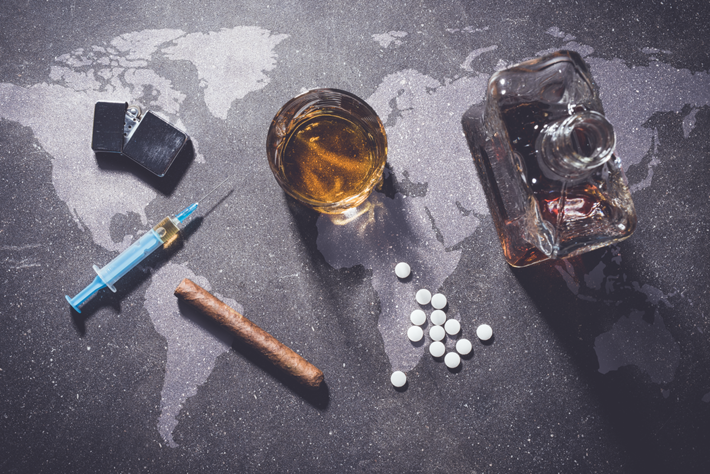Addiction in the World
Looking at the Problem on a Global Scale

When we examine drug and alcohol addiction as a severe humanitarian crisis, the first place we’re going to look is within our own families. We’ll check close to home, as this is the area that impacts our lives the most. If we don’t have anyone within our immediate lives that suffers from a substance abuse habit, we might zoom the camera lens out a bit, looking instead into our communities, neighborhoods, and towns.
But what if we zoomed the camera lens out even further? Perhaps to the state we live in? Suddenly the drug problem seems more ominous. It seems that every time we confront the drug problem on a larger scale, we see the problem from a whole new perspective. The drug problem looks more significant, more dangerous every time we and examine a larger geographic area.
So what would the drug crisis look like if we examined it on a global level?
The United States Has a Serious Addiction Epidemic, But…
When we seek information on drug addiction, almost everywhere we look is going to afford us with data about the drug crisis as an American issue, a severe problem in our country. And that's understandable. The drug problem in the United States is undoubtedly a full-on epidemic.
- According to the Centers for Disease Control and Prevention, about 10 percent of the U.S. population over the age of 12 struggles with some degree of illicit drug use. At least another two percent of the U.S. population over the age of 12 battles with the non-medical use of psychotherapeutic pharmaceutical drugs.
- Addiction is very costly to our nation. According to the National Institute on Drug Abuse, our country’s addiction problem (which includes prescription opioids, alcohol, tobacco, and illicit drugs) costs us about $740 billion annually. Those costs come from a variety of sources such as theft, lost work productivity, medical bills, collateral damage, the criminal justice system, and so on.
- The National Institute on Drug Abuse publishes statistics on drug overdose deaths (with the help of the CDC). According to their information, in 2017 (the most recent year for which we have completed information) more than 70,200 people died from drug overdoses. Compare that number to ten years prior, when 36,000 people died from drug overdoses. Or compare the number to 1999, when 16,800 people died from drug overdoses. The annual death toll from drug overdoses has increased by 400 percent just since the turn of the century.
The United States is struggling with a dire addiction crisis. No one denies that. But what happens when we zoom the camera lens out even further, when we look at drug and alcohol addiction on a global scale?
A Look Worldwide Addiction Statistics

Not all countries struggle with torrid drug problems publicly, but enough of them do to paint a global picture much like a magnified version of what we experience in the United States. The U.S. drug problem is terrible, and no one is minimizing that, but the problem on a global scale is much worse.
- According to the World Health Organization (WHO), the misuse of alcohol results in no less than 3.3 million deaths every year.
- Total deaths from drug overdoses are far fewer, yet still severe. The WHO estimates that 450,000 people die from drug overdoses every year.
- If we look at alcohol consumption worldwide, the yearly average consumption level for every human being over the age of 15 is 6.2 liters (1.6 gallons).
- But here’s where that gets interesting. Less than half the world population drinks any alcohol at all, so the average level of alcohol consumption just for the 15 and up population that does consume alcohol is actually 17 liters of alcohol every year. That’s 4.5 gallons of alcohol as the average.
- Since the typical individual who consumes alcohol socially would never even come close to 4.5 gallons of alcohol consumption per year, this means that there is a percentage of the world’s population that is consuming an extremely significant amount of alcohol every year—hence the high death rate.
- The global condition with drugs is also severe. Again according to the World Health Organization, about 31 million people struggle with drug addiction globally. About 11 million of them are IV drug users, and about 1.3 million have HIV, 5.5 million have hepatitis C, and 1 million have both.
- Global production of drugs and seizures of drugs are another good indicator of the drug problem. According to the United Nations Office on Drugs and Crime: “The global seizure of pharmaceutical opioids in 2016 was 87 tons. Global cocaine manufacture in 2016 reached the highest level ever reported, with an estimated 1,410 tons being produced. From 2016-2017, global opium production jumped by 65 percent to 10,500 tons, the highest estimate recorded by UNODC since it started monitoring global opium production at the start of the twenty-first century.”
The entire world is struggling with an addiction crisis. This problem is on its way to becoming the top health crisis in the world if it is not given the attention, proper effort, and solutions that it deserves.
Finding Help for Addiction No Matter Where You Are
No matter what scale we examine drug addiction on, whether it's familial, in the community, across the state, in the nation as a whole, or on a global level, the situation is depressing. But there is a silver lining here, and there is hope. No matter who one happens to be, where one lives, or what type of drug problem one struggles with, there is hope for overcoming drug and alcohol addiction.
Narconon is an international drug and alcohol addiction treatment program, one of the only international programs in the world and absolutely the only one of its kind. Narconon has residential addiction treatment centers in the United States, and all across the planet, from Mexico to Colombia, Denmark to Hungary, Italy to Macedonia, Spain to Sweden, the U.K to Nepal, and more. If you are seeking help for yourself or a loved one who struggles with drug or alcohol addiction, no matter where you are located, be sure to find support through a residential addiction treatment center as soon as possible.
Sources:
- https://www.cdc.gov/nchs/fastats/drug-use-illegal.htm
- https://www.drugabuse.gov/related-topics/trends-statistics
- https://www.drugabuse.gov/related-topics/trends-statistics/overdose-death-rates
- https://www.who.int/substance_abuse/facts/en/
- https://www.who.int/substance_abuse/information-sheet/en/
- https://www.unodc.org/unodc/en/frontpage/2018/June/world-drug-report-2018_-opioid-crisis--prescription-drug-abuse-expands-cocaine-and-opium-hit-record-highs.html
Reviewed and Edited by Claire Pinelli, ICAADC, CCS, LADC, RAS, MCAP


 ®
®